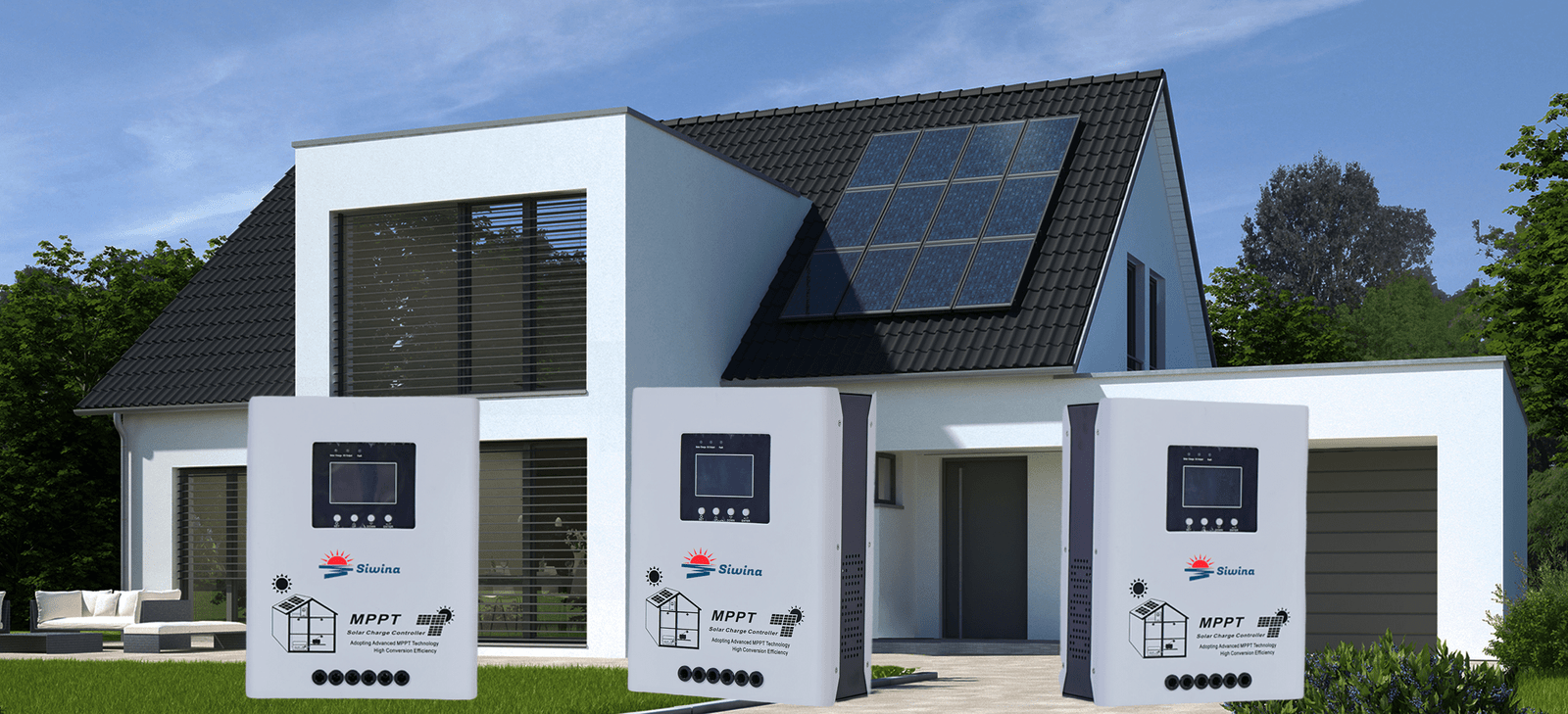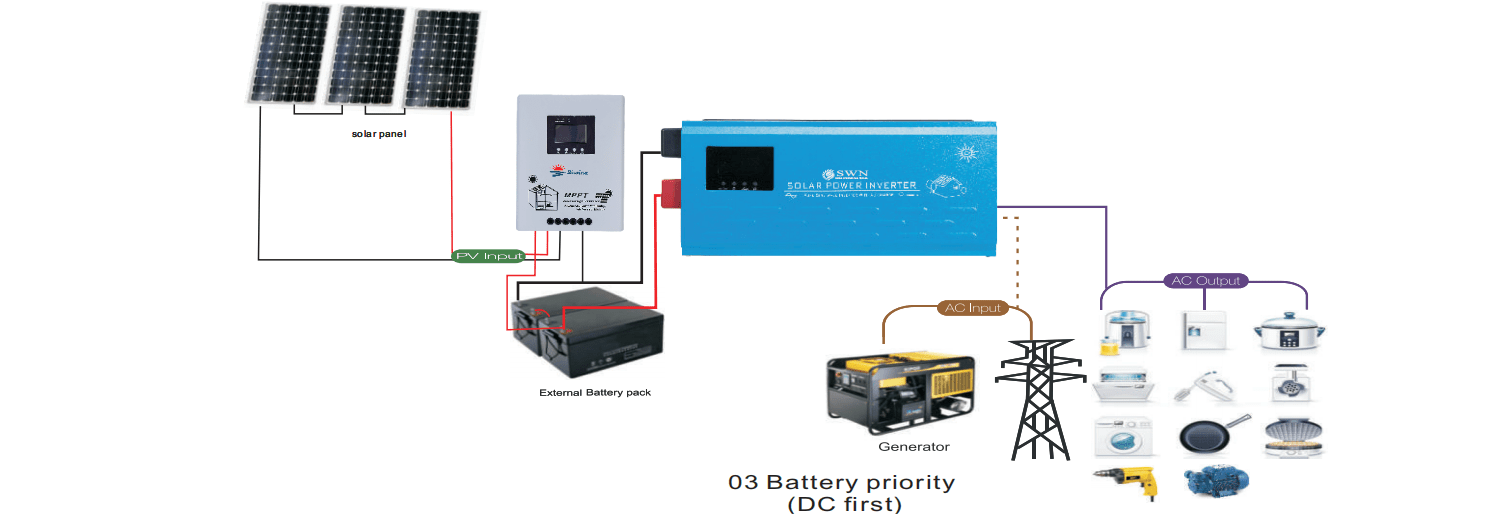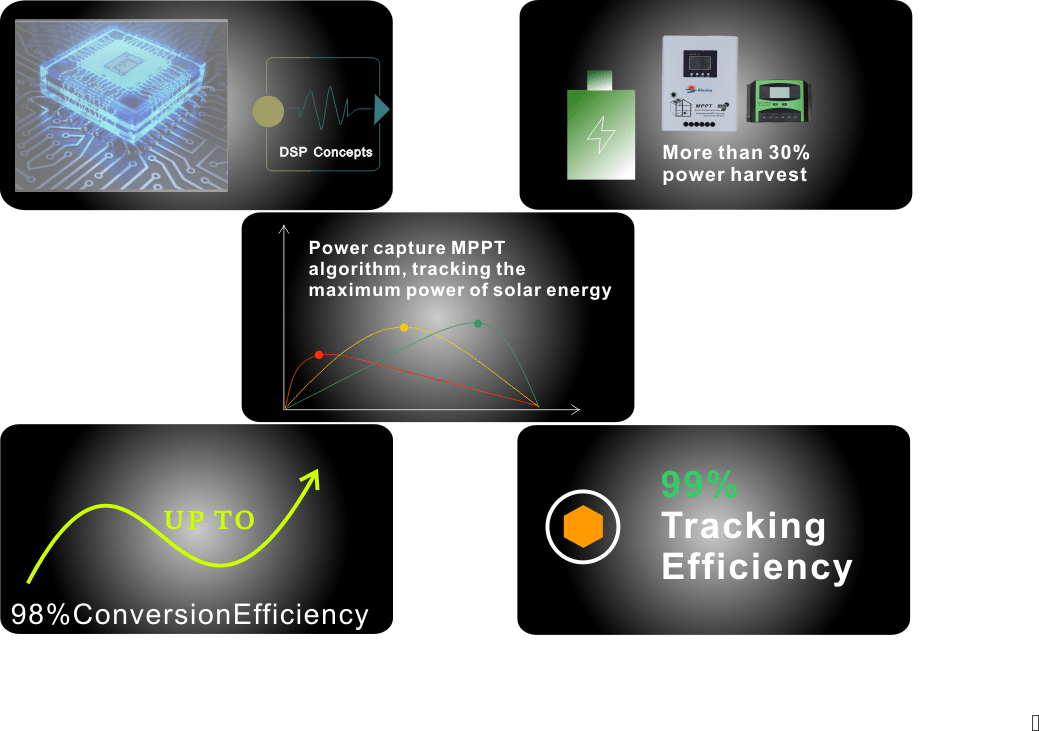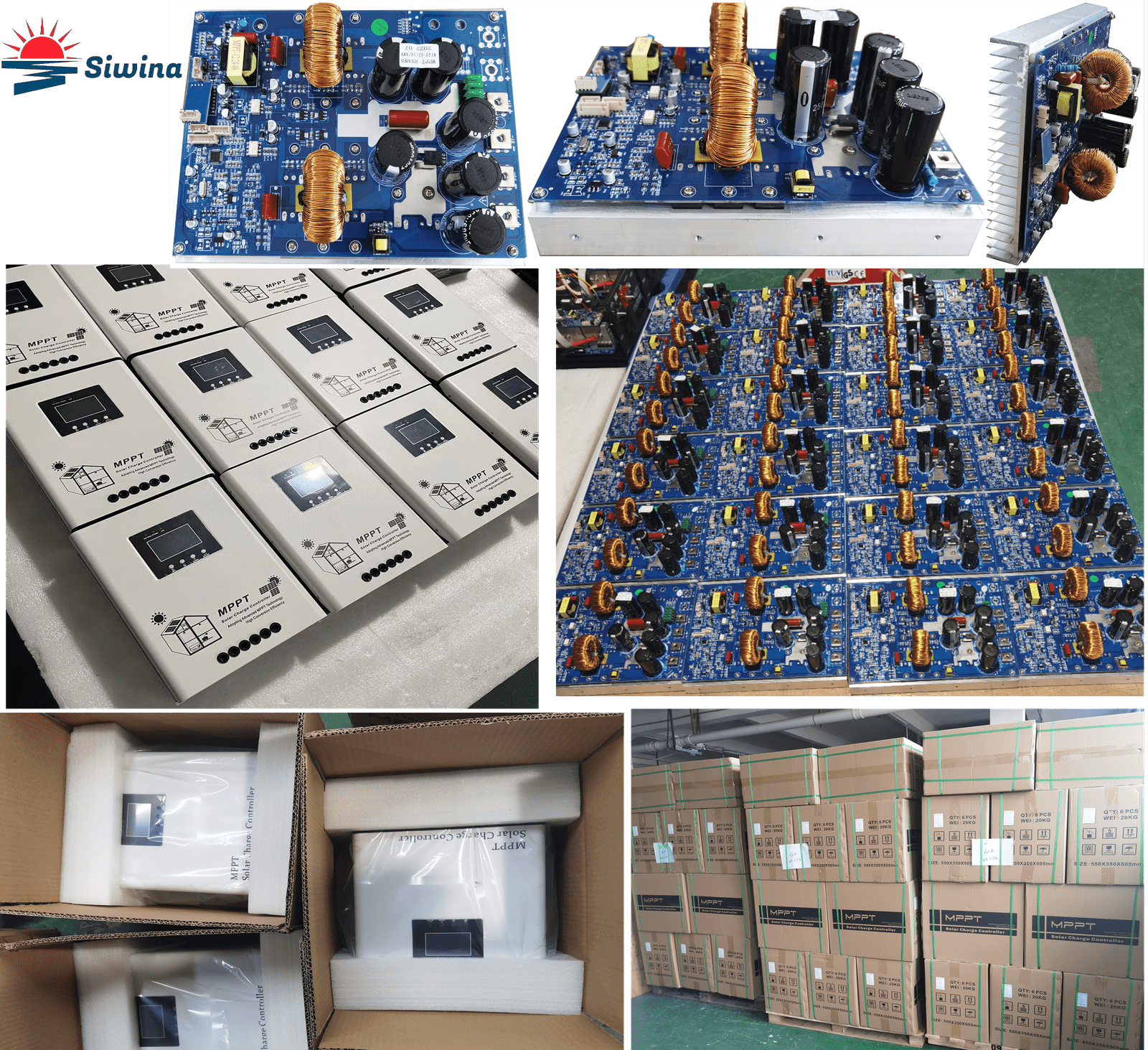The SWINA MPPT solar controller represents a significant advancement in solar energy technology through its implementation of ultra-fast Maximum Power Point Tracking (MPPT). This technology is especially useful when the sunlight intensity or temperature changes throughout the day, ensuring that you are always getting the most energy from your panels and enables the controller to continuously monitor and adjust to the optimal voltage and current output of solar panels.
| DC Voltage(Battery ) | 12VDC/24VDC/48VDC, 48VDC or 96VDC |
|---|---|
| color | White/blue/Green/orange |


Why Use an MPPT Solar Charge Controller?
Maximum Power Point Tracking (MPPT) solar charge controllers are essential components in solar power systems, particularly when optimizing energy harvest from solar panels. Here are the main reasons to use an MPPT solar charge controller:
Maximizes Solar Energy Harvest: MPPT controllers continuously track the optimal operating voltage and current (the “maximum power point”) of the solar panels to ensure that they deliver the maximum possible power. This is especially useful when the sunlight intensity or temperature changes throughout the day, ensuring that you are always getting the most energy from your panels.
Improves Charging Efficiency: MPPT controllers are more efficient than traditional Pulse Width Modulation (PWM) controllers, often achieving efficiency levels of 90-99%. This means more of the energy produced by your solar panels is used to charge your batteries, reducing energy loss and improving overall system performance.
Allows for Higher Voltage Panels: With an MPPT controller, you can use solar panels with a higher voltage than the battery bank. This flexibility can reduce the overall wiring costs and losses in the system, making the installation more efficient and potentially lowering the total system cost.
Adapts to Varying Weather Conditions: In conditions with variable cloud cover, sunlight intensity, or temperature, an MPPT controller dynamically adjusts to maintain optimal energy production. This adaptability is critical in environments where the weather can change rapidly.
Overall, the ultra-fast MPPT technology embedded in the SWINA solar controller not only optimizes energy capture but also significantly improves the performance and reliability of solar power systems. By leveraging this advanced technology, users can ensure that their investment in solar energy yields the maximum possible return, making it a smart choice for both residential and commercial applications.
How to Choose an MPPT Solar Charge Controller
Choosing the right MPPT solar charge controller involves considering several factors to ensure it matches your specific solar power system needs:
System Voltage Compatibility:
Ensure the MPPT charge controller is compatible with your battery bank’s voltage (12V, 24V, 48V, etc.). Some controllers are versatile and can handle multiple voltage settings, but always double-check to avoid compatibility issues.
Solar Array Voltage and Current Ratings:
Input Voltage: The controller’s maximum input voltage should exceed the maximum open-circuit voltage (Voc) of your solar panels. Remember to account for temperature variations, as Voc can increase in colder conditions.
Input Current: Ensure the controller can handle the short-circuit current (Isc) of the solar array. It’s important to choose a controller that can manage the combined current output if you have multiple panels in parallel.
Amperage Rating: The controller must handle the maximum current output of your solar panels. A good rule of thumb is to choose a controller with an amperage rating of 25-30% higher than the maximum current output to provide a safety margin for unexpected spikes or future expansion.
Maximum Solar Input Power: Check the maximum wattage the controller can handle. This should be higher than or equal to the total wattage of your solar array. For example, a 40A MPPT controller at 12V should handle up to 520W of solar panels.
Efficiency and Performance: Look for MPPT controllers with high conversion efficiency, ideally above 95%. Higher efficiency means more energy from your solar panels is converted into usable electricity for your batteries.
Durability and Quality: Consider controllers with robust build quality, preferably with certifications. This ensures reliable performance.
The SWINA MPPT solar controller is engineered to maximize battery longevity and uphold optimal performance, a critical aspect of any solar energy system. One of the standout features of this controller is its ability to charge batteries swiftly and efficiently, ensuring they remain in peak condition. This is particularly significant when considering the broad range of batteries it supports, including lithium, gel, AGM, conventional lead-acid (wet), and LTO types.
Maintaining battery health is pivotal in solar energy systems, and the SWINA controller excels by offering tailored charging algorithms for different battery types. These algorithms are designed to optimize the charging process, preventing overcharging and unnecessary strain on the batteries. This intelligent charging mechanism ensures that each type of battery, whether it’s a robust 12/24/48v 120a 150a 96v100a MPPT solar controller, receives the precise charging requirements it needs.
Moreover, the SWINA MPPT solar controller has the unique ability to recharge batteries with a voltage as low as 0 volts, provided they are not permanently damaged. This feature is invaluable in scenarios where batteries have been deeply discharged, as it affords users the opportunity to recover and restore them without the need for replacement. This capability not only extends the life of the batteries but also contributes to the overall cost-efficiency of the solar energy system.
By integrating advanced MPPT (Maximum Power Point Tracking) technology, the SWINA controller enhances the energy harvest from solar panels, ensuring that the batteries are charged with the maximum available solar power. This increased efficiency translates to faster charging times and prolonged battery life, which is particularly beneficial for high-capacity batteries like the 12/24/48v 120a 150a 96v100a MPPT solar controller.
In conclusion, the SWINA MPPT solar controller stands out for its comprehensive approach to battery health maintenance. Its ability to cater to various battery types, implement intelligent charging algorithms, and recover deeply discharged batteries underscores its indispensable role in any solar energy setup. The result is a robust, reliable system that ensures batteries remain healthy and operational for extended periods, optimizing both performance and longevity.
The SWINA MPPT solar controller is designed with advanced remote monitoring and control capabilities, ensuring users can manage their solar energy systems with convenience and efficiency. The inclusion of built-in Bluetooth and WiFi connectivity allows seamless pairing with smartphones or other smart devices, providing a robust interface for system management.
Through its intuitive app portal, users can access a comprehensive suite of functionalities. This portal is engineered to offer real-time updates on system performance, displaying crucial metrics such as current, voltage, and overall energy production. Whether you are managing a 12/24/48v 120a 150a 96v100a MPPT solar controller or similar configurations, the app ensures you are always informed about the operational status of your system.
Additionally, the SWINA MPPT solar controller’s app portal enables users to adjust settings remotely. This feature is particularly beneficial for optimizing performance across different weather conditions and energy demands. Users can customize parameters such as charge settings, load management, and safety thresholds, ensuring their solar setup operates at peak efficiency. Furthermore, the app provides alerts and notifications for any anomalies or maintenance requirements, allowing for prompt action to mitigate potential issues.
The remote monitoring and control capabilities extend beyond mere observation and adjustments. The app portal also offers historical data analysis, enabling users to track performance trends over time. This historical insight is invaluable for long-term planning and optimizing energy usage patterns. Whether you are monitoring a small residential setup or a larger commercial installation, the ability to analyze performance data enhances the overall utility of the 12/24/48v 120a 150a 96v100a MPPT solar controller.
By integrating these cutting-edge connectivity features, the SWINA MPPT solar controller ensures that users can harness the full potential of their solar energy systems with unmatched ease and precision. The emphasis on remote capabilities underscores SWINA’s commitment to delivering innovative solutions for modern energy management.
The SWINA MPPT solar controller is meticulously designed with a robust focus on safety and protection. Its insulated casing and high-quality insulation materials are pivotal in offering maximum protection against various electrical hazards, ensuring that the device operates safely under diverse environmental conditions. These materials are not merely about meeting industry standards; they aim to surpass them, providing an extra layer of security for users.
One of the standout features of the SWINA MPPT solar controller is its comprehensive suite of eight electronic protections. These include overcharge protection, which prevents the battery from receiving excessive charge, and short-circuit protection, which safeguards the system against abrupt electrical faults. Overload protection is another critical feature, preventing the system from handling more current than it is designed to manage. Additionally, high-low voltage protection ensures that the device can operate safely within a defined voltage range, protecting it from both high and low voltage anomalies.
The inclusion of over-temperature protection is significant, as it helps the system manage excessive heat, preventing potential damage to the internal components. Under-voltage protection is also integrated to prevent the battery from discharging to dangerously low levels, which can significantly reduce its lifespan. Overvoltage protection complements this by ensuring that the system shuts down if the voltage exceeds safe limits, thus protecting the entire setup.
These protections are not passive. They actively monitor voltage, current, and load changes, offering real-time responses to prevent overcharging and back-flow electrical currents. This continuous monitoring and adaptive response system ensures a safe and reliable charging process, significantly reducing the risk of damage to connected devices. By integrating these advanced safety and protection features, the SWINA MPPT solar contro

Brand Reputation and Reviews: Opt for brands with a strong reputation for quality and customer support. Check reviews and ratings from other users to gauge performance, reliability, and after-sales service.
Choosing the right MPPT solar charge controller is crucial for maximizing your solar power system’s efficiency, protecting your batteries, and ensuring long-term reliability. Consider your system’s specific requirements, such as voltage, current, and power ratings, as well as additional features and build quality, to make an informed decision.
Available Models: 12/24/48VDC120A, 150A, 96VDC100A
Technical Specifications
| Model | 30A | 40A | 30A | 40A | 50A | 60A | 80A | 100AB | 100A | 120A | 150A | 100A | |
|---|---|---|---|---|---|---|---|---|---|---|---|---|---|
| System voltage | 12V/24V | 12V/24V/48V | 48V/96V | ||||||||||
| Solar Input | 405W/810W | 540W /1080W | 405W/ 810W /1620W | 540W/ 1080W /2160W | 675W/ 1350W /2700W | 810W/ 1620W /3240W | 1080W/ 2160W /4320W | 1350W/2700W /5400W | 1350W/2700W /5400W | 1620W/3240W /6480W | 2025W/4050W /8100W | 5400W/ 10800W | |
| Charging type | MPPT automatic maximum power point tracking. | ||||||||||||
| Charging mode | fast charging, absorption charging, Pulse charging | ||||||||||||
| System mode | DC12V/24V automatic | DC12V/24V/48V automatic | DC48V/96V automatic | ||||||||||
| Efficiency | 98% | ||||||||||||
| Battery voltage range | 9V-16V(12VDC) | ||||||||||||
| 18V-30V(24VDC) | |||||||||||||
| 36V-60V(48VDC) | |||||||||||||
| 72V-120V(96VDC) | |||||||||||||
| PV INPUT | |||||||||||||
| Operating voltage and range | 90VDC | 14-130VDC(12V SYSTEM) 38-130VDC(24V SYSTEM) 72-160VDC(48V SYSTEM) 144-280VDC(96V SYSTEM) | |||||||||||
| Low voltage protection | 16V(12V SYSTEM) 30V(24V SYSTEM) 60V(48V SYSTEM) 120V (96V SYSTEM) | ||||||||||||
| Low pressure recovery | 22V(12V SYSTEM) 34V(24V SYSTEM) 65V(48V SYSTEM) 130V(96V SYSTEM) | ||||||||||||
| Overvoltage protection | 135V(12V/24V SYSTEM) 160V(48V SYSTEM) 280V(96V SYSTEM) | ||||||||||||
| Charging characteristics | |||||||||||||
| Selectable battery type | Lead-acid battery, GEL battery ,ithium battery | ||||||||||||
| Undervoltage shutdown | 10.2V(12VDC)/20.4V(24VDC)/40.8V(48VDC)/81.6V(96VDC) | ||||||||||||
| Undervoltage recovery | 11.5V(12VDC)/23V(24VDC)/46V(48VDC)/92V(96VDC) | ||||||||||||
| Battery overcharge protection | 14V(12VDC)/28V(24VDC)/56V(48VDC)/112V(96VDC) | ||||||||||||
| Charging current | 30A | 40A | 30A | 40A | 50A | 60A | 80A | 100A | 100A | 120A | 150A | 100A | |
| Over temperature alarm | 75℃ | ||||||||||||
| Over temperature recovery | 65℃ | ||||||||||||
| Size (MM) | 230*166*72 | 250*170*87 | 270*189*105 | 330*253*125 | 305*299*153 | ||||||||
| Packing size(MM) | 520*380*335(16PCS) | 470*308*395(6PCS) | 490*328*440(6PCS) | 400*338*392 (2PCS) | 470*360*210(1PCS) | ||||||||
| Packing Weight(KG) | 22.5 | 12.5KG | 19 | 19 | 20 | 10.5 | 10 | ||||||